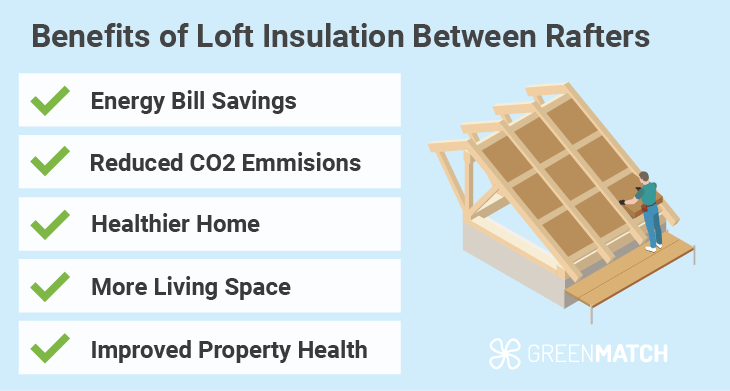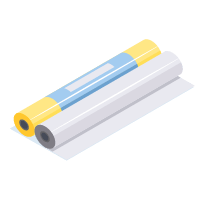Answer these simple questions and we will find you the BEST prices
Which type of solar quotes do you need?
It only takes 30 seconds
100% free with no obligation

Get Free quotes from insulation specialists near you

Save money by comparing quotes and choosing the most competitive offer

The service is 100% free and with no obligation
- GreenMatch
- Insulation
- Loft Insulation
- Rafter Loft Insulation
Loft Insulation Between Rafters: Your Complete Guide


- Insulating your rafters is also often referred to as warm loft insulation.
- It costs around £930 to insulate loft rafters in a 3-bedroom semi-detached UK house.
- Insulating your rafters can cut your home's heat loss by up to 26%.
You may wonder; is loft insulation worth it? Loft insulation between rafters is one of the most effective ways to reduce your home’s heat loss. This process involves installing insulation material to the underside of your roof, leading to regulated temperatures all year round. Loft rafter insulation can cut your energy bills by up to £270 and your carbon footprint by 0.6 tonnes every year
Better yet, between rafter insulation allows you to use your loft area as a living space, as it’s insulated alongside the rest of your home unlike with loft joist insulation. However, this isn’t just about sticking up insulation material and calling it a day. Your loft type, the insulation material you use, and your method of installation can all play a huge role in the final results.
If you’re wondering how to install loft insulation between rafters, this complete guide by GreenMatch UK will provide you with everything you need to know about loft insulation between rafters, including pros and cons, insulation materials, and the process from start to finish.
Already interested in insulating your loft? Look no further than GreenMatch UK for the most professional installers and the best bargains. Instead of spending countless hours on research and vetting, just spend 30 seconds filling out our online form to receive up to 3 free home-tailored quotes from accredited installers right in your area. Click below to begin!
- Describe your needs
- Get free quotes
- Choose the best offer
It only takes 30 seconds



Why is loft insulation between rafters important?

Loft insulation between rafters is also commonly referred to as warm loft insulation. This process of attic insulation is one of the most effective ways to upgrade your home's energy efficiency and comes with a wealth of benefits to consider.
Here are just some of the best benefits you can expect to bring to your home with proper loft rafter insulation in place:
- Energy bill savings: Insulating a loft ensures that your home is better at retaining internal temperature. This way, your heating system doesn’t need to constantly overwork to top up lost heat, leading to annual savings on energy bills of up to £370 in a detached UK home.
- Reduced carbon emissions: The UK housing stock is known as one of the least efficient throughout Europe. With proper rafter insulation, less heat escapes your home, leading to drastic improvements to your domestic carbon footprint. Loft rafter insulation can cut your CO2 emissions by up to 1 tonne in a detached UK home.
- Healthier home: A damp and drafty home is a breeding ground for mould and structural damage. Not only does this harm your investment, but also your health as mould weakens your immune system and increases respiratory illnesses. Loft rafter insulation can help regulate your home's internal temperature, ridding you of these problems.
- More living space: Unlike cold loft insulation, loft rafter insulation is when insulating material is fixed onto the underside of your roof. This way, your loft space is also insulated and can be prepped as a living or leisure space, not just storage!
- Improved property value: Upgrading energy efficiency with loft rafter insulation will raise your home’s Energy Performance Certificate (EPC) rating. This means that your property will be valued higher on the housing market if you ever plan to rent or sell it.
Some sources claim that loft rafter insulation is an effective method to soundproof your loft, but this is not necessarily true. Rafter in this case is thermal insulation, and there are different methods to insulate for noise.
With all things considered, loft rafter insulation is one of the best cost-to-benefit balances of all home insulation projects you could undertake to improve your domestic life.
What is the best loft insulation between rafters?
The best loft insulation between rafters is mineral wool insulation because it provides the best cost-to-performance ratio in terms of heat retention. It’s normally made from rock or glass and is one of the most affordable insulation materials on the market. Mineral wool is also eco-friendly and relatively sustainable to produce.
However, the best loft rafter insulation material and insulation costs can vary depending on your specific circumstances, such as your budget, loft type, existing insulation, and installation difficulty. The cost to replace loft insulation instead of starting from scratch may also differ. Taking these into consideration will help you make the best choice.
Let’s have a look at all of the main loft rafter insulation materials you will come across on the market.
Mineral wool

Mineral wool - made either from rock or glass - is one of the most popular materials used for insulating roof rafters due to its affordability, availability and eco-friendliness. Normally found as batts or sheets, mineral wool generally costs around £13 – £17.5 per m2 of material.
Sheets of mineral wool at a thickness of 270mm are cut into desired lengths and fitted in between and over the roof rafters, then secured in place with netting and covered with plasterboard for a clean finish.
- Budget-friendly.
- Sustainably produced.
- Easy to install, including DIY.
- Not ideal for crevices and hard-to-reach rafter areas.
- Can lose insulating capacity if compressed.
- Protective gear is needed as mineral wool will irritate if in contact with skin, eyes, or inhaled.
Sheep's wool

Sheep’s wool is a slightly more expensive loft insulation material than mineral wool, at about £17.5 – £22 per m2 but is considered one of the most eco-friendly, sustainable and effective insulators for roof rafters.
Being sustainably sourced, sheep's wool is easy to recycle and safe to dispose of. It also boosts some of the highest heat retention capabilities, often surpassing synthetic materials as well. Sheep wool can also be found as batts and applied in the same way as mineral wool.
- High heat retention capacity.
- Completely safe to handle, and allergy-free.
- Fully eco-friendly, sustainably sourced, and recyclable.
- Slightly more expensive than fibreglass and mineral wool.
- Can be vulnerable to insects if the wool is untreated.
Fibreglass

Fibreglass is a fibrous sheet-like loft insulation material made from recycled glass products that come in batts or sheets and can be applied just like mineral and sheep wool. It’s popular due to being one of the most affordable insulation materials on the market, at around £10 per m2.
It’s a relatively eco-friendly material that can be sustainably produced and recycled if disposed of correctly, making it a popular choice for roof rafter insulation.
- A very affordable option.
- Most options are fire and mould-resistant.
- Sustainably produced from recycled glass products.
- Protective gear is required as fibreglass will irritate if in contact with the skin, eyes or inhaled.
- Fibreglass isn’t the most efficient material in repelling moisture.
- Airborne particles from the insulation can trigger respiratory issues.
Rigid boards

Loft insulation boards between rafters come as rigid sheets that can be cut to size and fixed directly onto the roof rafters. Depending on the material the rafter insulation boards are composed of, costs and heat retention can fluctuate.
Synthetic boards- such as EPS Polystyrene or PIR (polyisocyanurate) boards - are some of the most effective on the market, costing around £5 – £15 per m2. The downside is that these materials are not eco-friendly, difficult to produce, and can even give off harmful toxins.
A much more eco-friendly yet effective alternative is cork boards. Made from recycled cork products, these rigid boards are effective insulators, costing around £17 - £22 per m2.
- Very high heat retention capabilities.
- Easy to install with no mess.
- Requires less insulation thickness than blanket-style insulators like mineral wool.
- Tends to be more expensive.
- Most options on the market are synthetic and produced unsustainably.
- Some polymer boards may release harmful VOCs and toxins after installation.
Foil insulation

Single or multi-layer rafter insulation foil is an aluminium-based membrane that is both affordable and easy to install onto roof rafters. Normally costing just around £3 - £4 per m2, it typically comes as two or more aluminium layers bonded with foam insulation and can reflect up to 97% of radiant heat, making it a great choice for your rafters.
- One of the most affordable options on the market.
- A durable option that doesn’t disintegrate over time.
- Moisture resistant, doubling as a vapour barrier.
- Must be cleaned and dusted frequently to retain heat effectively.
- Can be an electrical hazard if exposed to live wires.
- Not very effective in retaining heat, and will need to be combined with other insulation methods in colder climates.
Spray foam

Spray foam is applied to the underside of a roof by a professional with special equipment. It may boast some of the highest heat retention capabilities of all materials on the market, but is notoriously unsustainable, harmful to the environment, and can even lower your property value.
This is because foam insulation is difficult to remove, and most housing agencies consider it a burden in the long run. Spray foam insulation is also one of the most expensive options, costing around £30 - £70 per m2.
- One of the highest heat retention capabilities of all insulation materials.
- Quick installation of just several hours.
- Supports the structural integrity of your roof.
- Highly unsustainable, unrecyclable, and pollutive.
- Can off-gas harmful VOCs and toxins during and after installation.
- Reduces your property value as foam insulation is difficult to replace.
Different to thermal insulation, sound insulation roof materials are manufactured for better noise cancelling and can cost different to thermal materials. They also have different qualities.
All in all, the best insulation for loft purposes will hinge on a lot of factors, including your available budget, loft type, and personal preferences. Conducting a house assessment with a professional installer can help shed some light on the best approach for your needs.
What are the building regulations for loft insulation between rafters?
Loft insulation between rafters regulations follows standards set by the UK government. These regulations typically focus on insulation effectiveness for the most part, as well as measures to ensure that your insulation works efficiently for decades to come.
Here are the main regulations you may expect to face:
- Insulation thickness: The UK building regulations for warm loft insulation ask to achieve a U-value of around 0.20W/m². This technically means your loft space would be better insulated than even your home walls. This would require a minimum of 270mm of mineral or sheep wool insulation. For the best results, 300mm of insulation is best.
- Air gap: Ventilation is necessary so that the insulation doesn’t collect moisture, leading to mould, rot and structural damage. An air gap of a minimum of 25mm, or ideally 50mm, is recommended between the insulation and the underside of your roof tiles.
- Permissions: Generally speaking, permissions are not required from the local authority when carrying out a loft insulation project, however working with a professional installer can help make sure that if need be, a notice can be made on your behalf.
All in all, insulation between rafters and building regulations are quite straightforward to meet and are essential to follow to make sure you get the best benefits out of your loft insulation. If you plan to insulate a loft conversion, there are additional regulations in place to abide by.
How you can install loft insulation between rafters
If you’re wondering how to insulate an attic roof rafters, you’re in the right place. Installing loft insulation between rafters is generally straightforward, and can even be handled as a DIY project if you feel confident in your skills and research.
For homes that have an attic space, you’re likely looking at pitched roof insulation between rafters, as flat roof properties do not contain an attic space. Here’s how each style of insulation is secured onto loft rafters:
- Blanket (sheet) insulation
This group of insulation materials - such as mineral wool, sheep wool, and fibreglass - are installed by securing at least 270mm thickness insulation in between and over your roof rafters. A 25mm - 50mm air gap must be left between the material and the roof underside for adequate ventilation. The insulation is then secured in place with netting, ensuring that they’re not compressed. Finally, plasterboard is added in place for a seamless inner ceiling finish.
- Rigid boards
These materials - such as PIR or cork boards - are installed by cutting loft insulation to the desired size to fit snugly in between the roof rafters. Make sure this is as tight a fit as possible to help secure them in place by stapling the boards to the rafters. Just like blanket insulation, a 25mm - 50mm air gap must be left between the insulation and the roof underside for adequate ventilation.
- Spray foam
To install spray foam in your roof rafter, you must hire a professional insulation company to carry out the job. The installer will use a special applicator hose to spray the expanding foam in between your roof rafters. The whole process can take 1 to 2 hours in a standard home but may require to be ventilated for longer to avoid inhaling toxic off-gases.
Despite the short-term savings of a DIY installation, it’s highly recommended to work with a professional for your loft insulation installation. Accredited and trustworthy loft insulation installers make sure the job is done to the highest standards and within regulations, saving you from mounting repair costs and home structural damage from a faulty job.
Finding the right installer at the right price can be harder than it seems. It requires countless hours of research and vetting that most people simply don’t have time for. Luckily GreenMatch UK can handle all the hard work for you at absolutely no cost!
Simply fill in our 30-second online form, and receive up to 3 free home-tailored quote prices from our network of accredited installers right in your area. The best part? There are no charges or extra obligations. Click below to begin securing the best bargain for your home.
- Describe your needs
- Get free quotes
- Choose the best offer
It only takes 30 seconds



FAQ
Yes, you can use loft insulation between rafters. This style of insulation is often called warm loft insulation as it insulates your loft space alongside the rest of your house. This is an ideal approach if you plan to use your loft space for living purposes.
The best attic insulation between rafters is mineral wool insulation. It’s an affordable, easy-to-install, and effective material at retaining heat. However, an even more sustainable and effective alternative is treated sheep’s wool, found at a slightly higher price.
Loft insulation between rafters installation is different depending on the insulation material you opt for. The most popular approach is by fitting blanket-style insulation (mineral wool) in between and over your roof rafters, then securing these in place with netting before adding plasterboard to cover it up.
The UK government recommends a minimum 270mm depth of blanket-style insulation for your loft, but up to 300mm is considered effective and permissible. Generally speaking, there’s no need to add more insulation than this amount.

Akif is a copywriter at GreenMatch since 2023. With a keen interest in community sustainability, green solutions and the role of digital media in identifying climate trends, he aims to hone in on his background in International Studies and Digital Media to provide a multidisciplinary approach to written content rooted in credible research and accuracy.
We strive to connect our customers with the right product and supplier. Would you like to be part of GreenMatch?

